
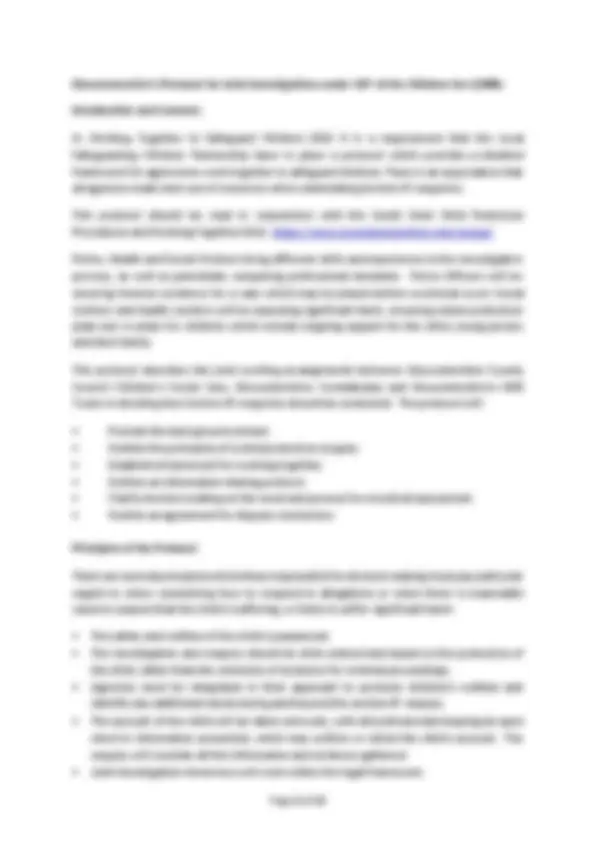
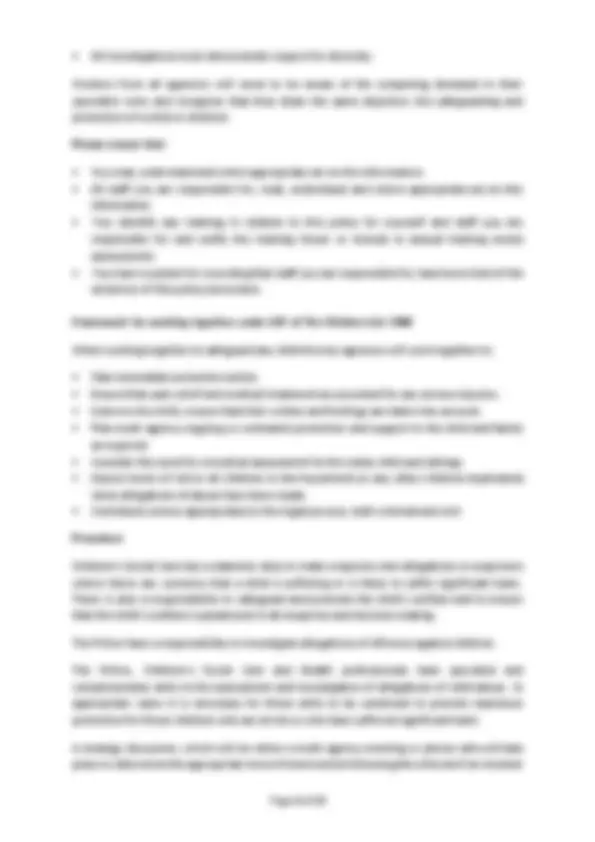

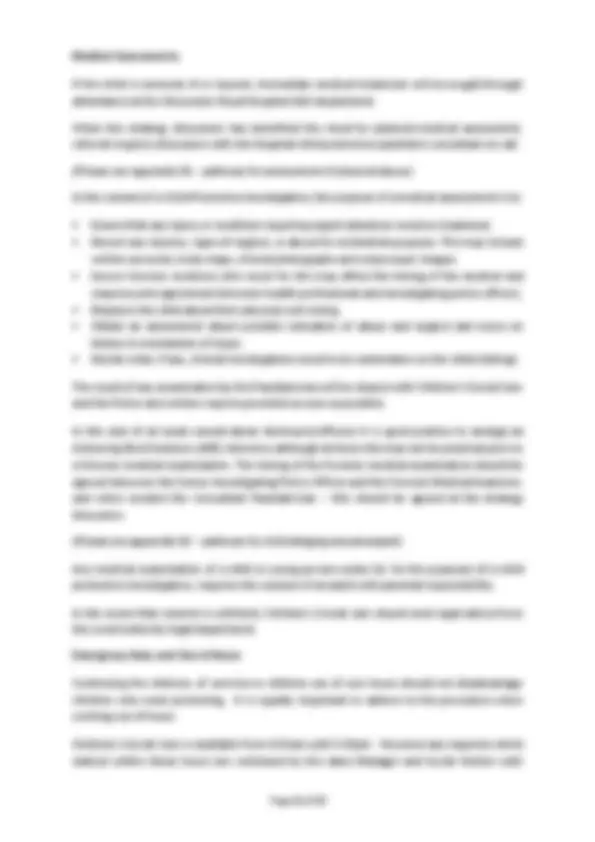
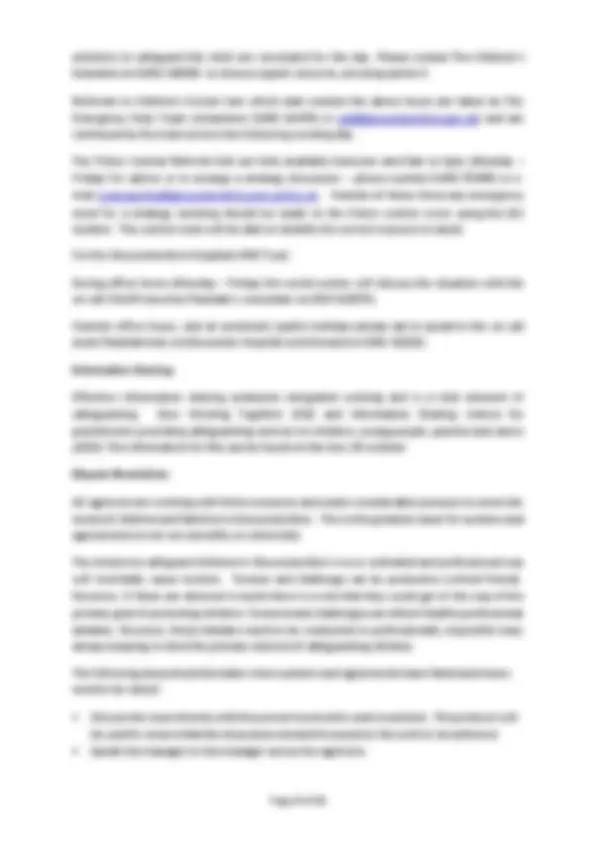
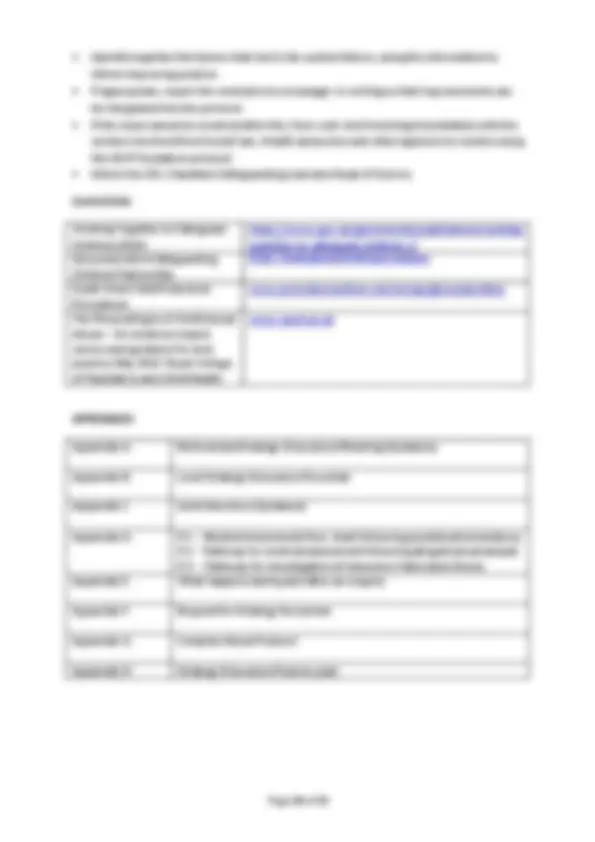
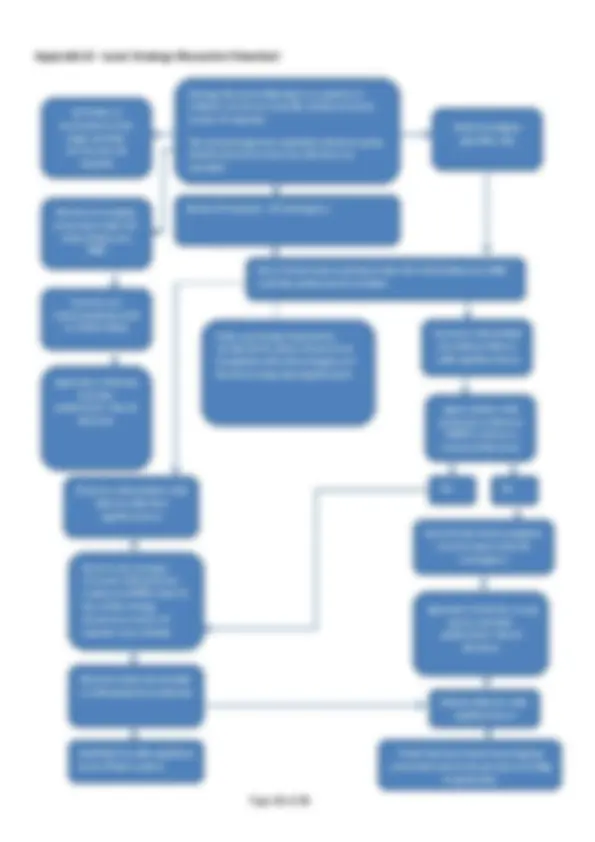
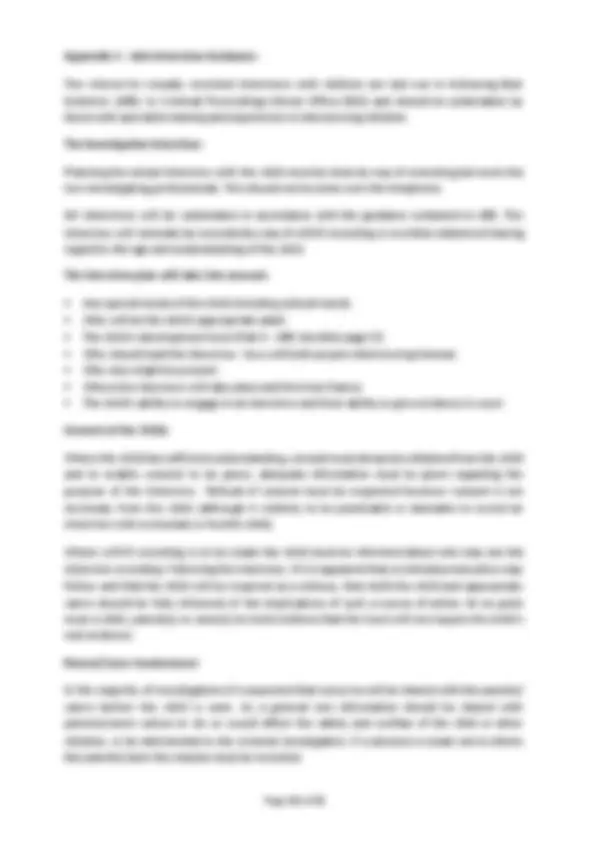
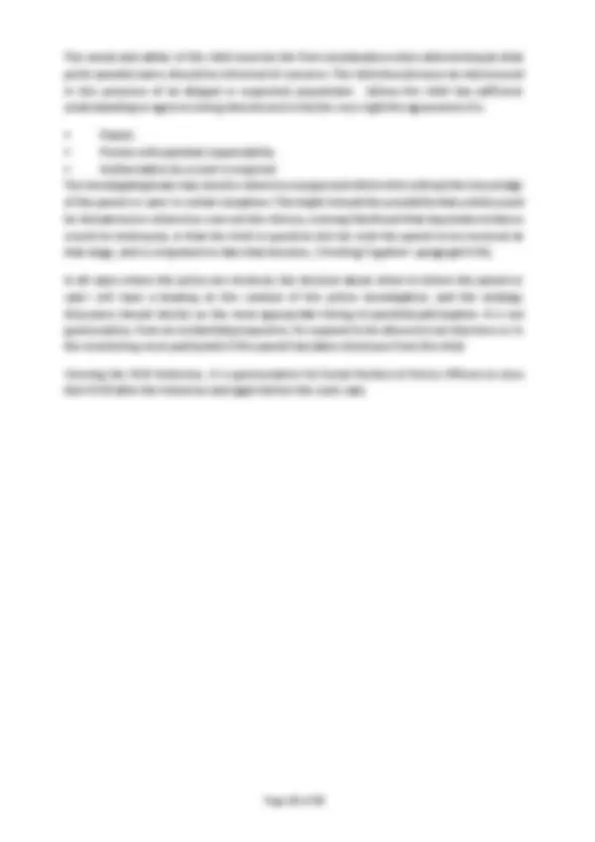


Study with the several resources on Docsity

Earn points by helping other students or get them with a premium plan


Prepare for your exams
Study with the several resources on Docsity

Earn points to download
Earn points by helping other students or get them with a premium plan
Community
Ask the community for help and clear up your study doubts
Discover the best universities in your country according to Docsity users
Free resources
Download our free guides on studying techniques, anxiety management strategies, and thesis advice from Docsity tutors
The principles and procedures for inter-agency cooperation in responding to allegations or suspicions of child abuse. It covers the roles and responsibilities of social workers, health professionals, and the police in assessing risk, conducting investigations, and making decisions to ensure the welfare and safety of children. The document also addresses the importance of information sharing, dispute resolution, and emergency services.
Typology: Exams
1 / 15

This page cannot be seen from the preview
Don't miss anything!










Version 1.4 – January 2021
Revision Table
Revision Date Comment 1.0 25 th^ August 2017 Protocol agreed and published on GSCP website 1.1 6 th^ March 2018 Minor changes to wording and updated diagram at Appendix C 1.2 4 th^ May 2018 Enhanced strategy discussion guidance, included local strategy discussion flowchart and amended organised and complex abuse section 1.3 28 August 2020 Protocol reviewed and updated to reflect current contact numbers. Addition of SCR Findings Pg6 and Pg 1.4 January 2021 Change from GCSE to GSCP
Workers from all agencies will need to be aware of the competing demands in their specialist roles and recognise that they share the same objective: the safeguarding and protection of a child or children.
Please ensure that :
Framework for working together under S47 of The Children Act 1989
When working together to safeguard any child the key agencies will work together to:
Procedure
Children’s Social Care has a statutory duty to make enquiries into allegations or suspicions where there are concerns that a child is suffering or is likely to suffer significant harm. There is also a responsibility to safeguard and promote the child’s welfare and to ensure that the child’s welfare is paramount in all enquiries and decision making.
The Police have a responsibility to investigate allegations of offences against children.
The Police, Children’s Social Care and Health professionals have specialist and complementary skills in the assessment and investigation of allegations of child abuse. In appropriate cases it is necessary for these skills to be combined to provide maximum protection for those children who are at risk or who have suffered significant harm.
A strategy discussion, which will be either a multi-agency meeting or phone calls will take place to determine the appropriate level of intervention following the referral of an incident
to the Police or Children’s Social Care (Joint investigation: The criteria for conducting a joint investigation of a referral of alleged/suspected child abuse is the likelihood that a criminal offence may have been committed (the likelihood of prosecution i s not a factor). To be recorded in Strategy meeting Minutes. The agreed actions MUST be agreed between Police, Health and Children’s Social Care
Subject to the recommendations of a Strategy Discussion, the following circumstances will result in a joint police and social work investigation.
The criterion for single agency investigation by Children’s Social Care : Where there is little or no likelihood of a criminal offence arising from the referral.
The criterion for single agency investigation by the Police : Where the alleged abuser is outside the child’s immediate family and parents or carers are protective and actively meeting the child’s needs.
However, all single agency investigations regarding children will be discussed with Children’s Social Care to confirm this status. Feedback and information will be shared at the time.
At any stage professional judgement may override the threshold criteria and lead to more or less action. Any changes of agreed action should be negotiated via another strategy discussion or discussion between the key agencies: the decision making should be fully recorded.
As part of this process, any paediatric review or examination of the child and siblings whether index case or sibling, will be shared with all agencies at section 47 thresholds.
Decide whether a section 47 enquiry under The Children Act 1989 should be initiated and undertaken. Agree and record whether the enquiry is joint or single agency and why. To decide whether there is a need for medical assessment, and if so who will carry out what actions, by when, and for what purpose. Determine what information from the strategy discussion will be shared with the family, without jeopardising the police investigation or causing significant harm. It is the social worker/Team Manager’s responsibility to ensure this happens in a timely and inclusive way. Agree the conduct and timing of any criminal investigation. To decide whether a Joint Interview (JI) will take place, to agree who should be interviewed by whom, for what purpose and when.
All strategy discussions and the decisions made will be recorded and agreed by all agencies. All strategy discussions will be signed off by a Manager for Children’s Social care.
It is agreed that the timing of all Strategy Discussions will be considered based on the risk posed to the child/ren. Wherever possible meetings/phone discussions will take place in a reasonable timescale based on the need but no longer than 5 working days after the concern of significant harm is raised.
Police Protection can only be considered at the time of the event and consultation needs to be had with the PPU inspector or the duty inspector when out of hours. On exercise of police protection powers, Children’s Social Care will be informed at the earliest opportunity.
What happens after a Strategy discussion?
Medical Assessments
If the child is seriously ill or injured, immediate medical treatment will be sought through attendance at the Gloucester Royal Hospital A&E department.
When the strategy discussion has identified the need for planned medical assessment, referral requires discussion with the Hospital child protection paediatric consultant on call.
(Please see appendix D1 - pathway for assessment of physical abuse)
In the context of a Child Protection Investigation, the purpose of a medical assessment is to:
The result of any examination by the Paediatrician will be shared with Children’s Social Care and the Police and written reports provided as soon as possible.
In the case of an acute sexual abuse disclosure/offence it is good practice to arrange an Achieving Best Evidence (ABE) interview although at times this may not be practical prior to a forensic medical examination. The timing of the forensic medical examination should be agreed between the Senior Investigating Police Officer and the Forensic Medical Examiner, and when needed the Consultant Paediatrician – this should be agreed at the strategy discussion
(Please see appendix D2 – pathway for child alleging sexual assault)
Any medical examination of a child or young person under 16, for the purposes of a child protection investigation, requires the consent of an adult with parental responsibility.
In the event that consent is withheld, Children’s Social care should seek legal advice from the Local Authority legal department.
Emergency Duty and Out of Hours
Continuing the delivery of services to children out of core hours should not disadvantage children who need protecting. It is equally important to adhere to this procedure when working out of hours.
Children’s Social Care is available from 9.00am until 5.00pm. However any inquiries which started within these hours are continued by the same Manager and Social Worker until
Useful Links
Working Together to Safeguard Children ( 2018 )
https://www.gov.uk/government/publications/working- together-to-safeguard-children-- 2 Gloucestershire Safeguarding Children Partnership
https://www.gloucestershire.gov.uk/gscp/
South West Child Protection Procedures
www.proceduresonline.com/swcpp/gloucestershire
The Physical Signs of Child Sexual Abuse – An evidence-based review and guidance for best practice May 2018 Royal College of Paediatrics and Child Health
www.rcpch.ac.uk
Appendix A: Referral and Strategy Discussion/Meeting (Guidance)
Appendix B: Local Strategy Discussion Flowchart
Appendix C Joint Interview (Guidance)
Appendix D: D 1 - Medical Assessment flow-chart following possible physical abuse. D 2 - Pathway for medical assessment following alleged sexual assault D 3 - Pathway for investigation of induced or fabricated illness Appendix E: What happens during and after an enquiry
Appendix F: Request for Strategy Document
Appendix G: Complex Abuse Protocol
Appendix H: Strategy Discussion Practice pack
Appendix A - Strategy Discussion (Guidance)
Please refer to South West Children Protection Procedures, the Gloucestershire Safeguarding Children Partnership and Working Together 2018 Procedures for further information.
Child Protection - Guidance Notes
1. Whenever there is reasonable to cause to suspect that a child is suffering, or is likely to suffer, significant harm, there should be a Strategy discussion, by meeting or telephone, involving Children’s Social Services, Gloucestershire Police and the appropriate Health professionals relevant to the child and/or family, the referring agency and any other appropriate bodies. This should take place in all instances, including those were the Manager and Social Worker have made a decision in supervision. Where the concern is relating to physical or sexual harm, The Gloucestershire NHS Hospital Trust must be included in the initial strategy discussion.
Note: When there is a disclosure of an allegation of a crime which impacts on a child or young person, an immediate referral must be made for a strategy discussion, to consider initiating or planning whether a Section 47 Investigation is required^2 .. This is in conjunction with any criminal investigation in order to identify the most appropriate action required to be taken to protect and support a child or young person and to preserve potential evidence
Serious physical injury/neglect – same day as receipt of concerns Penetrative sexual abuse – same day if forensic evidence is to be secured Emergency action by the Police or Children’s Services – within one working day Child in hospital setting – must take place before child leaves hospital Complex/organised abuse – maximum five working days unless need to provide immediate protection to a child
The purpose of the strategy discussion is to:
(^2) Children of Family Y SCR finding 2019
Appendix B – Local Strategy Discussion Flowchart
Strategy Discussion/Meeting is convened by LA children’s social care to decide whether to initiate section 47 enquiries. The minimum agencies required to attend are police, health and social work service. Decisions are recorded.
Concerns substantiated but child not likely to suffer significant harm
No further LA involvement at this stage, but other services may be required
Decision to complete assessment under S of the Children Act 1989
Agree plan with family and other professionals. Record decisions
Section 47 enquiries. 10 Working days
Social Worker leads assessment under S47 of the Children Act 1989 and other professionals contribute
Police investigate possible crime
Agree whether child protection conference /HRPM is necessary and record decisions
Yes No
Social Worker leads completion of assessment within 45 working days
Agree plan with family, young person and other professionals. Record decisions
Child not likely to suffer significant harm
Further decisions made about ongoing assessment and service provision according to agreed plan
Follow up strategy if required to include health, police and social care. Completed within 10 working days of the first strategy meeting/discussion
Concerns not substantiated but child is a Child in Need
Concerns substantiated, child likely to suffer from significant harm
Social worker manager convenes child protection conference/HRPM within 15 days of the strategy discussion at which s enquires were initiated
Decisions made and recorded at child protection conference
Child likely to suffer significant harm. CP plan in place.
Appendix C - Joint Interview Guidance:
The criteria for visually recorded interviews with children are laid out in Achieving Best Evidence (ABE) in Criminal Proceedings (Home Office 2002) and should be undertaken by those with specialist training and experience in interviewing children.
The Investigative Interview:
Planning the actual interview with the child must be done by way of a meeting between the two investigating professionals. This should not be done over the telephone.
All interviews will be undertaken in accordance with the guidance contained in ABE. The interview will normally be recorded by way of a DVD recording or a written stateme nt having regard to the age and understanding of the child.
The interview plan will take into account:
Consent of the Child:
Where the child has sufficient understanding, consent must always be obtained from the child and to enable consent to be given, adequate information must be given regarding the purpose of the interview. Refusal of consent must be respected however consent is not necessary from the child (although it unlikely to be practicable or desirable to record an interview with a reluctant or hostile child).
Where a DVD recording is to be made the child must be informed about who may see the interview recording. Following the interview, if it is apparent that a criminal prosecution may follow and that the child will be required as a witness, then both the child and appropriate carers should be fully informed of the implications of such a course of action. At no point must a child, parent(s) or carer(s) be led to believe that the Court will not require the child’s oral evidence.
Parent/ Carer Involvement
In the majority of investigations it is expected that conce rns will be shared with the parents/ carers before the child is seen. As a general rule information should be shared with parents/carers unless to do so would affect the safety and welfare of the child or other children, or be detrimental to the criminal investigation. If a decision is made not to inform the parents/carer the reasons must be recorded.